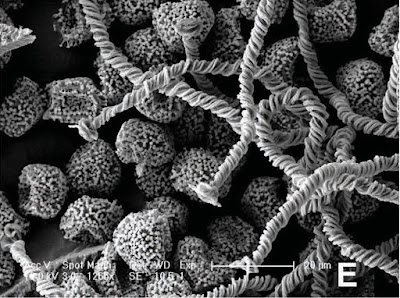Slime Molds are Eukaryotic organisms (organisms with cell nuclii) formerly classified as Fungi, but now regarded as not just unrelated to Fungi but paraphyletic (i.e. not all Slime Molds are related to oneanother). They spend most of their life-cycles as single-celled organisms, but when resources become sparce can coagulate to form a multi-cellular body which ranges from a few grams to a few tens of grams in size, which migrate in search of a suitable site then enter a spore-producing stage.
In a paper published in the journal Phytotaxa on 28 April 2016, Zhang Bo and Li Yu of the Engineering Research Center of Chinese Ministry of Education for Edible and Medicinal Fungi at Jilin Agricultural University describe a new species of Slime Mould from Jiangxi Province in China.
The new species is a Myxogastrian (Plasmodial or Acellular) Slime Mould, a group noted for producing large and conspicuous fruiting bodies, with the largest capable of producing single-celled fruit-bodies a meter across and weighing in excess of 20 kg. It is placed in the genus Trichia and given the specific name macrospora, meaning 'large-spores', the spores being larger than any other member of the genus.
Sporocarps of Trichia macrospora, many showing irregular dehiscence. Zhang & Li (2016).
The species was discovered living on a leaf of a Bamboo plant in the Junfeng Mountains of Jiangxi Province in July 2013. The species produces dark purplish-brown or brown sporangia on stipes (stems) 1-1.2 mm in length, which release rust-brown spores.
Trichia macrospora, Portion of the capillitium and spores, showing the ornamentation. Zhang & Li (2016).
See also...
 Chrysosporium guizhouense & Chrysosporium hubeiense: Two new species of Onygenal Fungi from China. Fungi of the Order Onygenales are Ascomycete Fungi capable of breaking
down keratin, the protein that forms skin, scales, hair and feathers in
terrestrial...
Chrysosporium guizhouense & Chrysosporium hubeiense: Two new species of Onygenal Fungi from China. Fungi of the Order Onygenales are Ascomycete Fungi capable of breaking
down keratin, the protein that forms skin, scales, hair and feathers in
terrestrial... Cryptosporidium discovery at water treatment plant leaves around 300 000 without drinkable water in Lancashire, England. Around 300 000 homes were left without drinkable...
Cryptosporidium discovery at water treatment plant leaves around 300 000 without drinkable water in Lancashire, England. Around 300 000 homes were left without drinkable... Pathogenic Oomycete Chromists from New Zealand, Hawaii and Côte d’Ivoire. Oomycete Chromists are Fungus-like micro-organisms which cause a wide
variety of infections in plants, such as Potato Blight and occasionally
animals, such as White Rots in aquarium Fish. It is also likely that...
Pathogenic Oomycete Chromists from New Zealand, Hawaii and Côte d’Ivoire. Oomycete Chromists are Fungus-like micro-organisms which cause a wide
variety of infections in plants, such as Potato Blight and occasionally
animals, such as White Rots in aquarium Fish. It is also likely that...
Follow Sciency Thoughts on
Facebook.


